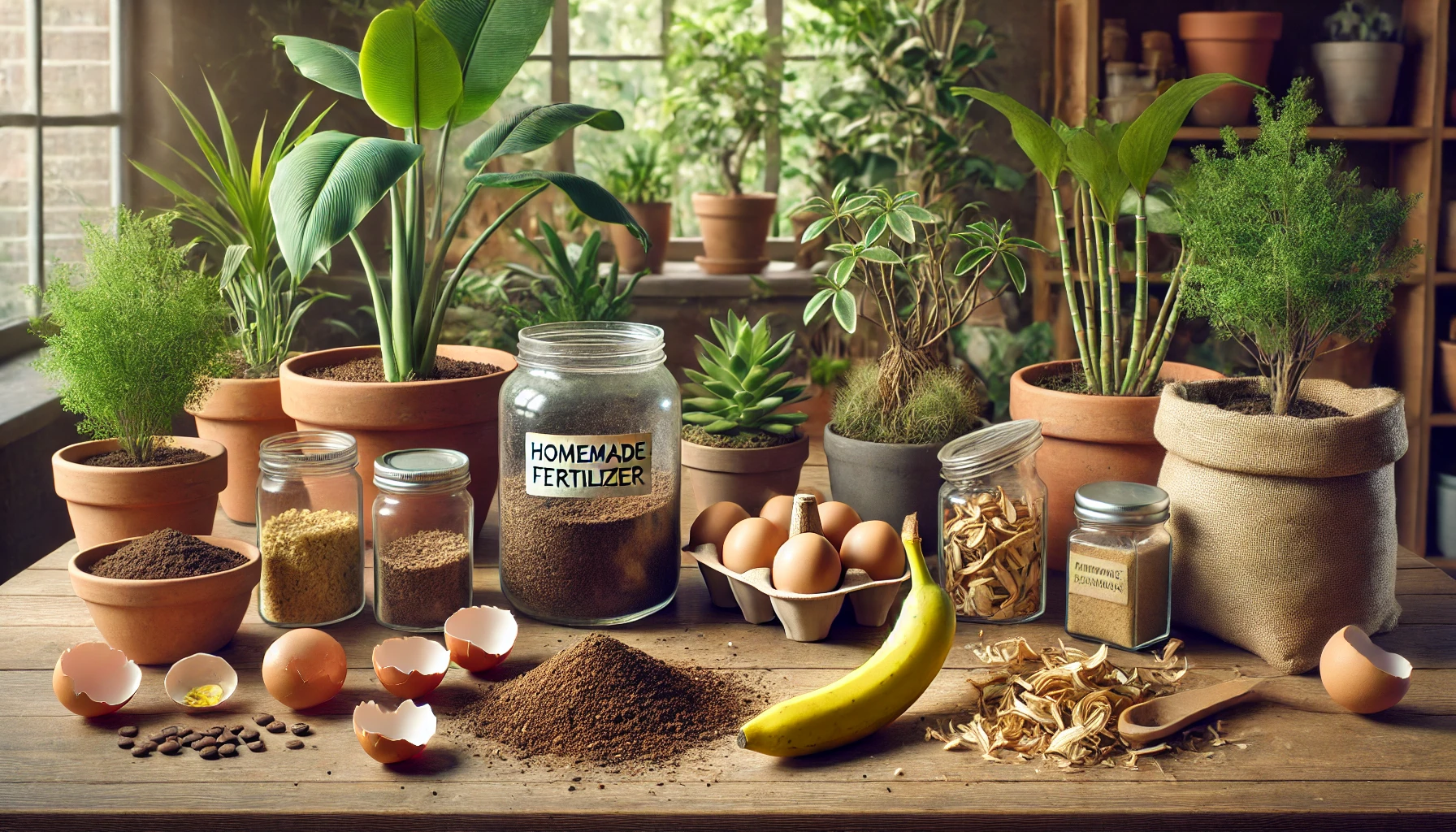Feeding your houseplants is essential to keep them strong, vibrant, and growing. But you don’t always need to run to the garden store for commercial fertilizers. Nature already provides a variety of organic materials that can nourish your plants — and many of them are probably in your kitchen right now.
In this article, you’ll learn how to make your own organic fertilizers at home, using natural ingredients that are safe, sustainable, and effective for indoor plants.
Why Choose Organic Fertilizer?
Organic fertilizers are made from natural, biodegradable materials. They release nutrients slowly, improve soil health, and pose less risk of overfeeding or burning plant roots.
Benefits of going organic:
- Gentle on plants and soil
- Reduce waste by reusing kitchen scraps
- Safe for kids, pets, and pollinators
- Long-lasting results
Perfect for houseplants, organic fertilizers support steady growth without harsh chemicals.
What Nutrients Do Plants Need?
Before creating your own fertilizer, it’s helpful to understand what plants are looking for:
- Nitrogen (N) – For leafy growth and green color
- Phosphorus (P) – Supports root development and flowering
- Potassium (K) – Aids overall strength and resistance
Other essential micronutrients include calcium, magnesium, and iron — all of which can be found in homemade sources.
Easy Homemade Organic Fertilizers
Here are some of the best and simplest natural fertilizers you can make for your indoor plants:
1. Banana Peel Fertilizer
Banana peels are rich in potassium, phosphorus, and calcium.
How to use:
- Chop the peels into small pieces.
- Bury them in the potting soil (just under the surface) or blend them with water to make a liquid feed.
- Apply once a month.
Great for flowering plants or fruiting houseplants like dwarf citrus.
2. Coffee Grounds
Used coffee grounds are high in nitrogen and help enrich the soil.
How to use:
- Let grounds dry completely before applying.
- Sprinkle a thin layer on the topsoil or mix into compost.
- Don’t overuse — excess can lead to acidity or mold.
Best for leafy plants like pothos, ferns, or peace lilies.
3. Crushed Eggshells
Eggshells provide a slow-release source of calcium, which strengthens cell walls and helps root growth.
How to use:
- Rinse, dry, and crush into fine pieces or powder.
- Mix into soil or sprinkle on top.
- You can also steep in warm water for a few days to make a calcium “tea”.
Especially useful for plants prone to leaf tip burn.
4. Vegetable Scrap Compost
Composting is the gold standard for organic feeding — and it can be done on a small scale indoors.
How to use:
- Save scraps like lettuce, carrot tops, potato peels, and fruit rinds.
- Let them break down in a countertop compost bin or Bokashi system.
- Add finished compost to your potting mix (10–20% by volume).
Adds a full range of nutrients and improves soil texture and microbial life.
5. Rice Water
Leftover water from rinsing or boiling rice contains starch, minerals, and micronutrients that benefit plant roots.
How to use:
- Collect cooled rice water.
- Use it to water your plants once every 2 weeks.
- Avoid water with added salt or oil.
Provides a gentle nutrient boost and can support soil bacteria.
6. Aquarium Water (from Freshwater Tanks)
Fish waste is packed with nutrients that act as a natural fertilizer.
How to use:
- Use old aquarium water (not newly treated or chlorinated) to water your plants.
- Apply every 2–4 weeks.
Be sure it’s from a freshwater tank, not saltwater.
7. Molasses Mixture
Molasses contains sugars and trace minerals that feed beneficial soil microbes.
How to use:
- Mix 1 tablespoon of unsulfured molasses into 1 liter of water.
- Use as a monthly feed for mature plants.
Improves microbial activity and soil health.
How to Apply Homemade Fertilizers Safely
Even organic fertilizers can cause harm if used improperly. Here’s how to apply them the right way:
- Start small — always test a little first to avoid overfeeding.
- Don’t fertilize too often — monthly is usually enough for indoor plants.
- Use during active growth — typically spring and summer.
- Avoid feeding sick or newly repotted plants — let them adjust first.
- Label your mixes — so you don’t forget what’s in your jar or bottle.
Observe how your plants respond, and adjust as needed.
Bonus Tip: Make a Simple Fertilizer Tea
Want an all-in-one liquid fertilizer? Try this easy mix:
Ingredients:
- 1 banana peel
- 1 tablespoon coffee grounds
- Crushed eggshells
- 1 liter of water
Instructions:
- Blend all ingredients or steep in warm water for 24–48 hours.
- Strain and use to water your plants.
This homemade “plant smoothie” provides a mix of major nutrients and is safe for most houseplants.
Final Thoughts: Feed Your Plants, Naturally
Feeding your plants doesn’t have to mean buying bottles of synthetic formulas. With a little creativity and a few kitchen scraps, you can create a sustainable, natural fertilizer routine that supports healthier, happier plants — and reduces waste in the process.
Start small, use what you already have, and let your plants (and your wallet) thank you.
